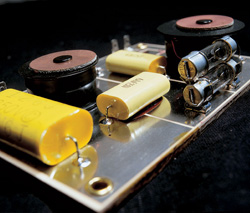
Problems
The single biggest problem is that one passive cabinet (or a pair) won’t play loud enough and clean enough for large spaces. If the sound system is for your bedroom or garage, passive systems would work just fine—maybe even better. But it isn’t.
Once you try to fill a relatively large space with equally loud sound you start to understand the problems. And it doesn’t take stadiums, just normal size clubs. It is really difficult to produce the required loudness with passive boxes.
Life would be a lot easier if you could just jack everyone into their own cans amp—like a bunch of HC 4 or HC 6 Headphone Amps scattered throughout the audience. Let them do the work; then everyone could hear equally well, and choose their own listening level.
But life is hard, and headphone amps must be restricted to practice and recording.
Monitor loudspeakers, on the other hand, most likely have passive crossovers. Again, it’s a matter of distance and loudness. Monitors are usually close and not overly loud—too loud and they will feed back into your microphone or be heard along with the main mix: not good.
Monitor loudspeakers are similar to hi-fi loudspeakers, where passive designs dominate … because of the relatively small listening areas. It is quite easy to fill small listening rooms with pristine sounds even at ear-splitting levels.
But move those same speakers into your local club and they will sound thin, dull and lifeless. Not only will they not play loud enough, but they may need the sonic benefits of sound bouncing off close walls to reinforce and fill the direct sound. In large venues, these walls are way too far away to benefit anyone.
So why not use a bunch of passive boxes? You can, and some people do. However, for reasons to follow, it only works for a couple of cabinets. Even so, you won’t be able to get the high loudness levels if the room is large. Passive systems can only be optimized so much.
Once you start needing multiple cabinets, active crossovers become necessary.
To get good coverage of like-frequencies, you want to stack like-drivers. This prevents using passive boxes since each one contains (at least) a high-frequency driver and a low-frequency driver. It’s easiest to put together a sound system when each cabinet covers only one frequency range.
For instance, for a nice sounding 3-way system, you would have low-frequency boxes (the big ones), then medium-sized mid-frequency boxes and finally the smaller high-frequency boxes. These would be stacked or hung, or both—in some sort of array.
